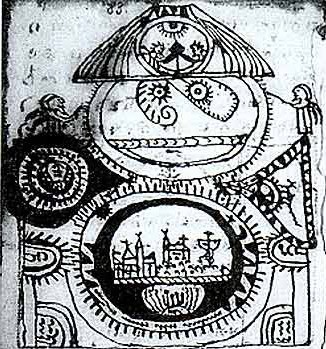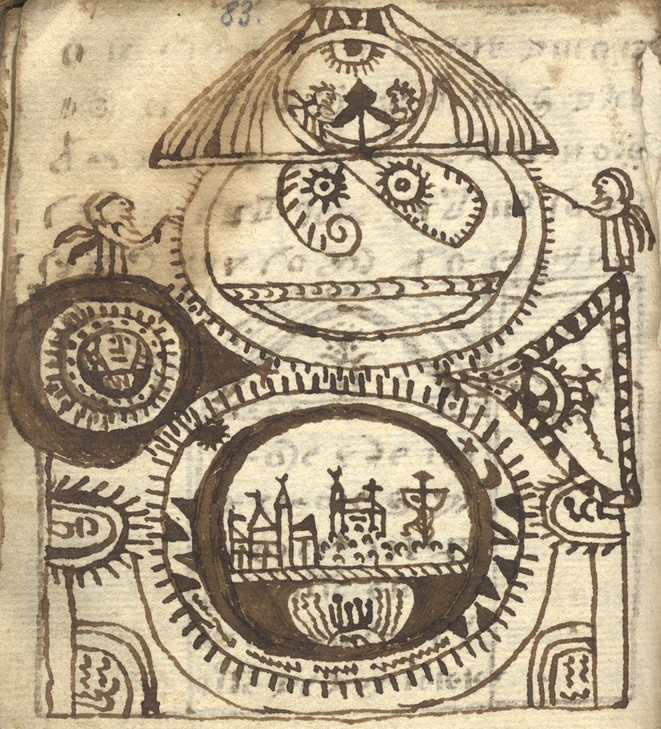I haven’t really put as much time into the Rohonc Codex as I would like: but in my defence, this has been because the available scans are fairly miserable. For example, here’s the scan of the drawing on the page marked ’83’:-
However, a recent post from the Centre for the Study of Manuscript Cultures (‘CSMC’) at the University of Hamburg offers us a glimpse of what might be possible with better quality Rohonc scans. (This whole story was broken by Klaus Schmeh’s Krypto Kolumne a few days ago, well done Klaus!)
With this scan, you can clearly make out that this drawing is depicting some kind of curious clockwork device, though – as cipher mysteries connoisseurs would perhaps expect – it’s still as clear as mud what is going on with it.
If only the rest of the Rohonc Codex could be scanned in broadly the same quality, and a proper codicological description of its construction put together! Then we could all really go to town on it, not just Benedek Lang. 🙂


This is a passing comment, no more – but I notice that on scan (page?) 26, the scene of the crucifixion of Christ shows the blood falling from his hands is being caught in cups (chalices) by a pair of winged figures. This is a theme which is found in other fifteenth century manuscripts, but it might have been a bit political when and where it was made. The Hussite rebellion etc. If the written part of the text is enciphered, this might, perhaps, be a reason for it. Just a thought.
.. of course, Christ wasn’t the only person crucified, crucifixion was practised from before the time of the Roman empire, though the Romans were especially given to the practice.
The Alamanus manuscript is dated to c.1475-1485. It has technical details for 30 different clocks, including escapements and strikers. A friar called ‘Paul the German’ wrote it in Rome, from unknown sources.
Staats-und Stadtbibliothek Augsburg Codex in 2o No.209.
Sickle moons and crosses, a ship under full sail, clockwork being moved by humans manipulating the interlocked wheels with sticks or rods. Allegory for what keeps the wheels of commerce (slavery?) (or time?) turning? Clothing and hair styles tell some of the story, too.
Note the presence of a ‘portrait’. I’m still reading for more info on various sea and seaport battles between Venetians, Ottoman, Spanish, Portuguese, French, Algerian, Greek and African.harbors and ports.
Jeff, thanx for the ref to ‘Alamanus’. I love to follow up on other comments/leads — just to satisfy my ‘bump of curiousity’.
bd-eyed-wunderer
Even the word “Rohonc” seems strange to me. If the word were originally spelled ‘Rahonc’ or ‘Anchor’, maybe the drawings and text would be more interpretable?
Some notes to provide context:
The top of the figure shows the pair of ‘strikers’ as winged and bearded, gowned males in the head-dress of the princes of Pharaonic Egypt.
This image of what are effectively a pair of bearded ‘angels’ is so unusual that one is tempted to suggest the origin of the image Phoenician, or actually Egyptian.
Certainly we can trace the development of automata to before the time of Alexander, it being a skill attributed to those tribes who were walled up by Alexander, and later attested more firmly by the works of Heron of Alexandria and (later) Philo of Byzantium and, of course, by the Antikythera device.
However, I do not think that the manuscript’s content is necessarily as old as that – among some German-speaking communities of the middle ages, and until about 1600, there survived stories about the so-called ‘Red Jews’ which may derive from memory of the Phoenicians (poinike described a red-purple, like the colour of dates or of Tyrian puple dye).
These ‘Red Jews’ were also associated with the peoples walled up by Alexander beyond the Caspian gates, those tribes usually identified with Alans, or Comans etc., but which the Jewish and Christian legends linked to a Biblical pair “Gog and Magog” whose re-appearace and descent on Jerusalem was to signal the end of days. By some in medieval Europe the ‘Red Jews’ were further associated with the Khazars, and/or with the Alans.
I’m inclined to think, then, that the pair at the top of the folio represents the somewhat sinister messengers, and possibly intentionally the legend of German communities about ‘Red Jews’.
Interestingly, Gog and Magog were still used to represent the classic pair of strikers who sound the clock’s hour as tocsin and warning that time is fleeting, and finite, while the end may come at any hour.
See: http en wikipedia org/wiki/Royal_Arcade,_Melbourne#/media/File:Gog%26Magog-1,-Royal-Arcade,-Melb,-11.08.2008.jpg
Of particular interest in this codex is the assignment of different forms of headwear. It is of interest not only for its accurate understanding that the stiped Egyptian head-dress (e.g as show on Moses confronting Pharaoh) signalled a ‘prince of Egypt’ as Moses was, but for its knowledge that the imperial/religious headwear was different. That shown in the same image looks to me a degraded form of the white crown of Egypt.
Also, we see the assignment of the Magi’s (or possibly here the Radhanite’s?) pointed cap to a number of figures which, in the way of Latin or Byzantie Christian works, we should expect to see identified by a Roman helmet, arms and tunic (with or without the apron of leather stips).
The group for whom the manuscript was made is thus likely to be a non-indigenous group within the German-speaking regions. Ideally, we should be able to identify it by reference to the close-fitting, ear-covering cap given John ‘the beloved disciple’ (shown kneeling by the cross), but the design was not at all uncommon and examples of it occur as late as the nineteenth century, when it is still found as a form of men’s night cap. The distinction is that the majority of medieval caps like that have straps to them ~ see for example images in the Fécamp Psalter of . 1180 AD (MS 76 F 13, Koninklijke Bibliotheek, The Hague).
Rohonc and Vms:
With relation to the Vms, to which I daresay many will hope to link the Rohonc codex in the hope of arguing a wholly German-speaking provenance for the former, I have to say that apart from an interesting use of patterning, including some similar details (e.g. the points of the roof in the ‘crown of thorns’ image), there is not much that the two have in common as regards what we might call their world view.
In the way typical of most western works, and indeed most works of the Greco-Latin world, the Rohonc codex’s imagery is intensely focused on men, their status, power, actions and material possessions.
This is the great absence from the Vms imagery, and the one which should long ago have alerted those researching it that its genesis lies outside the bounds of Greco-Latin culture, and western European Christian culture in particular. Content, of course, is not manufacture, and the question of whether or not the Vms was made in Europe remains open.
Not that Europe was the only place in the world where manuscripts were made of vellum, nor inscribed using iron-gall ink.
apologies for the odd typos. I blush to admit there’s coffee on the keyboard.
I’ve noticed the appearance of very fine lines in the manuscript material — reminiscent of the semi-transparent notepaper used for “AIR MAIL” letters (lighter weight, and the fine lines kept the writer’s sentences from slanting; so the most space for the most writing).
Quite often, I was able to match the disintegrated cuckoo clocks with the remainder of the flimsy pasteboard boxes in which they had been mailed (Black Forest souvenirs).
🙂
I’m afraid that I don’t have Jacques Guy’s endurance – but the comment above was my version of a “Manchu hypothesis”, to see if any reader might call it.
Guy’s test of the old Vms mailing list was unexpectedly proven viable but I do not expect the same fluke to occur.
For this type of clock, should there not have been pendulum activity being portrayed? Note the fly-wheel (?) at the very top of the illustration.
A harbor with what appears to be an out-bound ship. What kind of time-keeping instrument would have been used to ring the ship’s ‘bells’ ?
How about the word ‘chrono’ (?)
I still have memory of a different type of time-pieces: the hourglass, and minute-glass (60 seconds for the sand to fill the lower section)…….just about the time it took me to type this comment. (Another 60 seconds to proofread and post!)
beady-eyed 1-der
An hour glass. Most ships had several.
One more type of ‘chrono’: At the Academy of Sciences Museum, in Golden Gate Park, San Francisco, California, is a fabulous ‘time-keeping’ pendulum (perpetual movement) which would knock over a peg every several suspenseful minutes.
Nick, Diane, & other interested (at all) parties: Have you had a chance to view Golden Gate Park’s huge pendulum which is activated by the earth’s rotation — and marks passing time on the floor (pegs to be knocked over by the pendulum). There is also a compass rose on the floor. Basically, one can tell local time, as well as time on the ‘opposite shores’. Fascinating, and quite beautiful.
bdid1dr
Nick, can you give us a timeline for when towns started building clock towers?
😉
bdid1dr: about 1300 or so in Europe for what we would recognize as a modern-looking clock (though these usually had only a single hand). See: http://en.wikipedia.org/wiki/Clock_tower
Is there a clear consensus that this this is written Right to Left? It seems like it was written by a left hander. I found a curiosity on page 63 it looks like the writing is slightly different.
It looks like a weird cross between Ge’ez and Egyptian demotic. to me, anyway.
Thanx, Nick, for the blue-link (wiki) — fascinating! Have you gotten any clues, yet, for translating the subject codex?
Tomorrow, I’m off to another GOC festival. I’ll ask if I can browse their library for how they kept time for their observances.
🙂
A manuscript written in “Astomtavruli” – looks a bit like the Rohonc script.
A picture of it in the wiki article
http://en.wikipedia.org/wiki/Georgian_scripts
Tricia: Georgian scripts run from left to right, while the Rohonc script apparently runs from right to left. And the paper used is, apparently, Italian and can be dated to circa 1530-1540.
My impression, for what it’s worth, is that the characters were chosen to look different and so exotic and/or confusing. There are passing resemblances to various scripts, but I don’t think anything structural or consistent has been identified.
I’ll leave the wondrous machines to others braver and/or better qualified than me!
seriously this time.
People interested in the codex might find useful a paper by Donald R. Hill, ‘The Banu Musa and the Book of Ingenious Devices’. First published in the History of Technology 2. London: Mansell Publishing Ltd., (1977),
and reprinted (1998) by Ashgate (Variorum series, general editor David A. KIng), in Medieval Islamic Technology from Philo to al-Jazari – from Alexander to Diyar Bakr.
See the 2nd circle of that page: Christ is hanged and crucified on a mountain (in front of a church on a mountain too). I dont’ see titulus crucis, a black square instead. Sotty my english isn’t good.
See the 2nd circle: Christ is hanged and crucified in front of a church (both on mountains). There isn’t titulus crucis, a black square instead. Sorry, my english isn’t good.